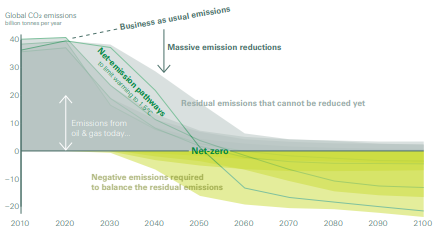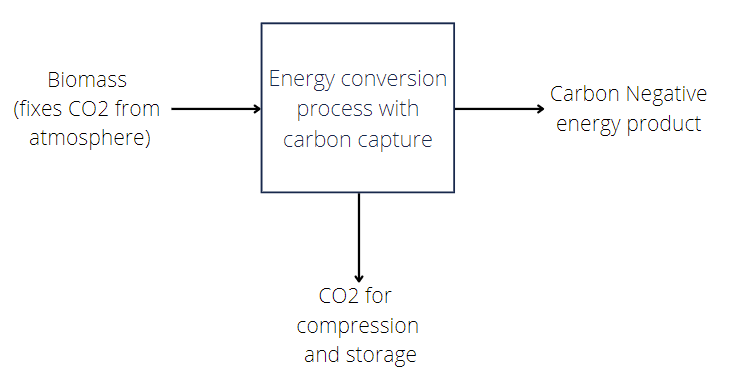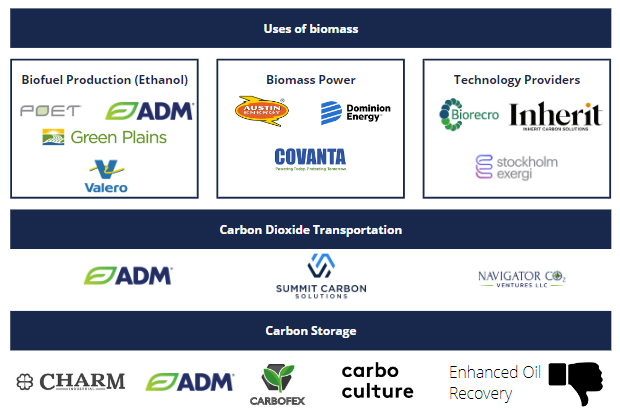Gigaton Potential
The US National Academy of Sciences estimates that Bioenergy with Carbon Capture and Storage (BECCS) could result in 3.5 - 5.2 GT/yr of carbon removal globally by 2050.
For reference: in 2019, the world emitted 51 gigatons of CO2-equivalent greenhouse gasses. Project Drawdown estimates we need to cumulatively eliminate 1,000 GT from 2020-2050 to keep global warming below 2 degrees Celsius
You Might Be Interested If…
You are looking for ways to “pull two weeds with one yank”
You are excited to explore an underinvested-in area
You believe that carbon removal is necessary and you want to leverage existing technologies
What You Should Know
What is Carbon Dioxide Removal and do we need to do it?
Carbon dioxide removal (or CDR) is the process of removing carbon dioxide from the atmosphere after it has been released. There are many ways to do CDR, from nature-based methods like reforestation to engineered techniques like direct air capture (DAC). CDR is not a replacement for deep decarbonization - eliminating our reliance on fossil carbon should be our first, second, and third priority. However, because of difficult to abate sectors like aviation and agriculture, and to allow for catch-up growth in developing economies, we will almost certainly need to deploy CDR at a meaningful scale.
Figure 1: Net-emissions pathways to limit global warming to 1.5 degrees Celsius. Sourced from Swiss Re: which was in turn adapted from IPCC 2018
According to the National Academies, “[CDR] will play as significant a role as any mitigation technology, with perhaps 10 GT/yr of CO2 of negative emissions needed approximately at midcentury...” (NASEM, 2019). Check out the CDR Primer and the Carbon Removal Academy for a deeper dive.
How does BECCS fit in?
CDR systems are commonly delineated into two categories; nature-based CDR, where nature (i.e. plants) is responsible for capturing and storing the CO2, and engineered systems, where technology does the capturing and storing. BECCS straddles this neat distinction. It refers to a set of technologies where biomass is converted into an energy product (electricity, heat, liquid fuel, etc.), and carbon is captured and stored or utilized.
Figure 2: BECCS inputs and outputs, adapted from presentation for the Institute of Carbon Removal Law and Policy
Here’s a more concrete example of BECCS: a coal-fired power plant is converted to run on municipal solid waste and retrofitted with a carbon capture unit. The plant burns the biomass to generate electricity, and in the process creates a high-concentration stream of CO2, which can be captured and stored. Carbon captured through this process can be stored for >1000 years (compared with ~100 for most nature-based solutions) at a lower cost than DAC.
What’s the catch?
BECCS can permanently capture and store CO2 at a lower cost than direct air capture while also generating a useful energy product… sounds great, right? Well, there’s a catch. BECCS relies on biomass feedstocks and is deeply intertwined in the complicated push-pull of land-use. If a dedicated energy crop is grown for BECCS, that land can no longer be used for food production, meaning new land may be “reclaimed” to convert to agriculture, resulting in a net increase in carbon emissions versus the do-nothing scenario.
Even for waste feedstocks where no agricultural displacement occurs, it isn’t always clear that BECCS leads to net negative emissions once you account for transportation, processing, and alternative uses.
Key Players
Despite the vast scientific literature on BECCS, it has yet to see the same explosion of new companies as other forms of carbon removal. As of today, there are only 5 BECCS facilities in operation in the US, with the 1Mt / yr capacity project operated by Archer Daniels Midland (ADM) in Illinois being by far the largest. However, an area tangential to BECCS, biomass carbon storage, has seen an explosion of companies investing in things like biochar, bio-oil, and wood vaults. While not technically BECCS, we are still including them below.
Figure 3: Current BECCS value chain
Opportunities for Innovation
Solve the Feedstock Issue
As issues around carbon so often do, the effectiveness of BECCS ultimately comes down to accounting. If we can find biomass feedstocks that do not result in negative land-use changes, are widely available, and do not require significant transportation emissions, BECCS can be an environmentally beneficial and profitable investment.
Carbon Dioxide Infrastructure
The scale of infrastructure needed for carbon transportation and storage is widely underappreciated, and we will need to make massive investments in carbon infrastructure. Summit Carbon Solutions is leading the charge here, but much more is needed.
Help Companies Monetize Carbon Incentives
Managing the complicated thicket of government incentives around carbon is challenging, but the ability to do so successfully is often the difference between a project getting funded or not.
About the Author
TJ Considine is a former fintech PM who is making the leap into carbon removal by way of a Berkeley MBA. Reach out to talk about carbon markets, air mining, and Chicago Cubs baseball.
Sources
Surveying the BECCS Landscape, Energy Futures Initiative, Jan 2022
A Midwest pipeline promises to return carbon dioxide to the ground, Grist
US Electricity Generation, US EIA
Introduction to BECCS, Institute for Carbon Removal Law and Policy
Summary of Negative Emissions Technologies, National Academies
Archer Daniels Midland Company, US DOE
Biomass Carbon Removal and Storage Roadmap, Innovation for Cool Earth Forum
Negative Emissions Technologies and Reliable Sequestration, National Academies






